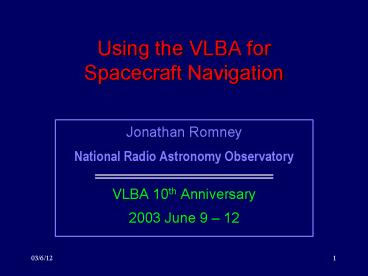Using the VLBA for Spacecraft Navigation - PowerPoint PPT Presentation
Title:
Using the VLBA for Spacecraft Navigation
Description:
National Radio Astronomy Observatory. VLBA 10th Anniversary. 2003 June 9 12. 03/6/12 jdr ... Stardust was in far southern Ecliptic, at -22 degrees declination. ... – PowerPoint PPT presentation
Number of Views:137
Avg rating:3.0/5.0
Title: Using the VLBA for Spacecraft Navigation
1
Using the VLBA forSpacecraft Navigation
- Jonathan Romney
- National Radio Astronomy Observatory
- VLBA 10th Anniversary
- 2003 June 9 12
2
Collaborators
- John Benson
- Walter Brisken
- Vivek Dhawan
- Craig Walker
3
Overview
- Basic Concept
- Initial Tests
- Proposed Pilot Project
- Implementation Phase
4
Basic Concept
- Precision Differential Astrometry
- Use well-established VLBA phase-referencing
technique. - Image spacecraft downlink transmitter
- measure (time-dependent) offset, relative to
suitable reference sources. - Close Analog
- Observations of maser sources, referenced to
continuum calibrators. - Primary difference source moves relative to
references.
5
Basic Concept
- Conventional Spacecraft Navigation
- Primarily based on range, measured as integrated
velocity. - Supplemented by single-baseline VLBI technique.
- Bandwidth-synthesis-like side tones required to
resolve fringe ambiguity. - Yields delay as fundamental observable.
- VLBA Multi-Baseline Technique
- 45-baseline observation eliminates fringe
ambiguity, as in normal imaging. - Provides absolute celestial coordinates directly.
6
Basic Concept
- Synthesis
- Precise two-dimensional celestial coordinates can
enhance range-based navigation substantially. - Overall 3-dimensional navigation capability could
be simultaneously more precise, less expensive,
and operationally simpler.
7
Overview
- Basic Concept
- Initial Tests
- Proposed Pilot Project
- Implementation Phase
8
Initial Tests August December 2002
- Experimental Target
- Stardust.
- Mission to sample and return dust from Comet Wild
2 2004 January 2. - (Successful close flyby of Asteroid Annefrank
2002 November 2.) - Test Observations
- October December 2002.
- Imaged Stardust with 5 mas resolution, 1001
dynamic range. - Phase referencing only partially successful.
- Stardust was in far southern Ecliptic, at -22
degrees declination. - Reference sources 2 6 degrees distant.
- Successfully measured position offset once, 12
mas relative to predicted orbit.
9
Initial Tests
- Experimental Modifications to VLBA
- Schedules kluged to point to Stardust.
- Downlink schedule transmitted by fax.
- Correlator software modified to add moving source
coordinates. - NAIF/SPICE system previously used for moving
station in Space VLBI correlation. - But best ephemeris expected is equivalent to
SVLBI predicted orbit reconstructed orbit
would require same input we aim to provide. - Near-field correction, already implemented in
correlator model server, tested for first time. - (VLBAs near field extends to 100 AU at X-band!)
10
Overview
- Basic Concept
- Initial Tests
- Proposed Pilot Project
- Implementation Phase
11
Proposed Pilot Project
- Study Goals Feasibility
- Evaluate feasibility of VLBA spacecraft
navigation. - Achievable angular precision, under various
observing conditions, for various spacecraft
characteristics. Goal 0.5 nano-radian. - Enhancement of overall spacecraft navigation
resulting from addition of VLBA angular position
measurements. - Determine optimal observing strategy.
- Required instrumental sensitivity and density of
reference sources. - Estimate impact on VLBA observing load.
- (Expected to be possible to interleave with
ongoing observations, with minor impact.)
12
Proposed Pilot Project
- Study Goals Implementation Plans / budgets
for - New equipment.
- 33-GHz receiver systems new spacecraft downlink
band. - Wideband Mark 5 recording systems essential for
sufficiently dense catalog of reference sources. - Replacement for correlator PBI current
bandwidth bottleneck. - Software upgrades.
- Scheduling pointing.
- Rapid bandwidth switching.
- Correlation model accountability.
- New operational procedures.
- Scheduling.
- Shipping.
13
Proposed Pilot Project
- Status
- Discussions with NASA began in January 2003.
- NRAO proposal positively received.
- Anticipating NASA will fund Pilot Project in near
future - but details of how it will work still being
worked out.
14
Overview
- Basic Concept
- Initial Tests
- Proposed Pilot Project
- Implementation Phase
15
Implementation Phase
- Assuming Successful Outcome of Pilot Project
- NRAO will propose implementation phase.
- Two-year duration planned.
- Implementation Project Would Include
- New equipment 3 GHz / new PBI / Mark 5.
- Software upgrades.
- Development of new operational procedures.
- Compilation of 33-GHz reference catalog.
16
Thank You!
- For exploiting the VLBAs many capabilities
- to achieve all the great science reported in
these four days - And for coming to our Anniversary Party!































